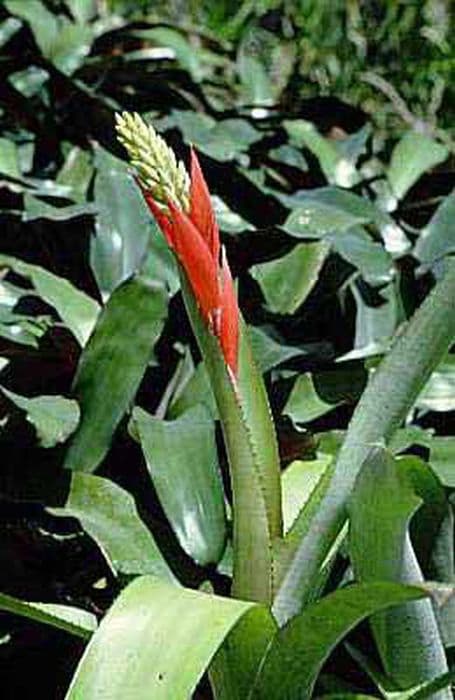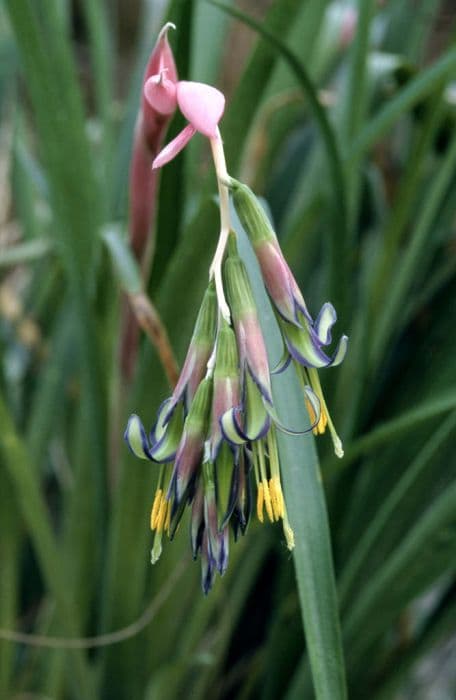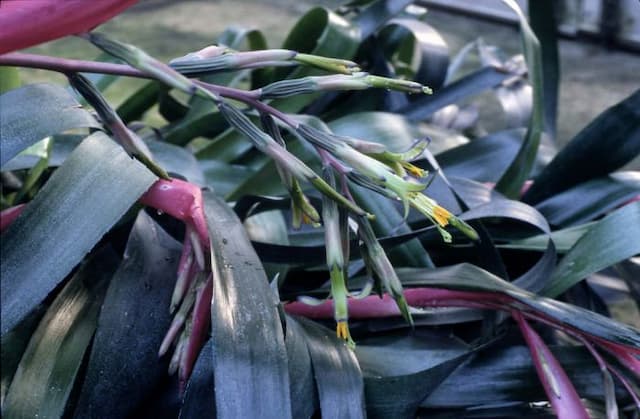Sapphire Tower Puya alpestris

ABOUT
Puya alpestris, commonly known as Sapphire Tower, is a striking plant that catches the eye with its unique and vibrant features. The most prominent aspect of its appearance is the impressive flower spike that it produces. This spiked tower is covered in turquoise or metallic blue flowers with bright orange anthers that create a stunning contrast, providing a spectacular display of color that can brighten any garden or natural landscape. The leaves of Sapphire Tower are thin and long, forming a dense, spiky rosette at the base of the plant. These leaves are typically a silvery-green or grayish-green color and can have sharp edges, which make the plant look formidable as well as beautiful. The overall presentation of Puya alpestris is one of both beauty and resilience, with its flower spike standing out as a breathtaking feature among the tough, spiny foliage.
About this plant
 Names
NamesFamily
Bromeliaceae
Synonyms
Sapphire Tower
Common names
Pourretia alpestris, Puya azurea, Puya berteroana, Puya caerulea, Puya clava-herculis, Puya coerulea, Puya glabrescens, Puya goudotiana, Puya laegaardii, Puya lanuginosa, Puya laxa, Puya lessonii, Puya tricolor.
 Toxicity
ToxicityTo humans
Sapphire Tower is not known to be toxic to humans. There are no widely recognized symptoms of poisoning because it is not generally considered a poisonous plant. However, it is generally advisable to avoid ingesting parts of ornamental plants due to the potential for individual allergic reactions or irritation.
To pets
Sapphire Tower is not known to be toxic to pets. Similar to its effects on humans, there are no widely known toxic effects or specific symptoms of poisoning for animals. Nevertheless, it is always best to prevent pets from consuming plants not meant for their diet, as they could cause digestive upset or an allergic reaction.
 Characteristics
CharacteristicsLife cycle
Perennials
Foliage type
Evergreen
Color of leaves
Silver-green
Flower color
Turquoise
Height
3-4 feet (0.9-1.2 meters)
Spread
3-4 feet (0.9-1.2 meters)
Plant type
Shrub
Hardiness zones
8
Native area
South America
Benefits
 General Benefits
General Benefits- Aesthetic Appeal: Puya alpestris, also known as Sapphire Tower, adds exotic visual interest to gardens with its striking steel blue flowers and silvery-green foliage.
- Drought Tolerance: As a member of the Bromeliad family, Sapphire Tower is well-suited to dry conditions, making it an excellent choice for water-wise gardens.
- Pollinator Attraction: The vibrant flowers attract pollinators such as hummingbirds, contributing to the health of the local ecosystem.
- Low Maintenance: Sapphire Tower is known for being relatively low maintenance, requiring minimal care once established in the right conditions.
- Unique Landscaping Element: Due to its uncommon appearance and flower structure, Sapphire Tower can serve as a unique focal point in landscaping designs.
- Adaptability: This plant is adaptable to a range of soil types as long as they are well-draining, allowing it to be cultivated in various garden settings.
- Long Blooming Season: Sapphire Tower has a long blooming season that can last several weeks, providing extended color and interest in the garden.
 Medical Properties
Medical PropertiesThis plant is not used for medical purposes.
 Air-purifying Qualities
Air-purifying QualitiesThis plant is not specifically known for air purifying qualities.
 Other Uses
Other Uses- Puya alpestris, commonly known as Sapphire Tower, can be used as a source of natural dye given its vibrant blue to green inflorescences.
- The tough fibers from the leaves of Sapphire Tower can be used to create ropes and fishing lines in traditional crafts.
- The nectar within the flowers of the Sapphire Tower serves as a valuable food resource for hummingbirds and other nectar-feeding birds.
- Sapphire Tower can be used as a living fence or barrier due to its large size and spiky foliage, which can deter animals and unauthorized access to an area.
- The plant can play a role in ecological conservation by providing habitat and support for various insects, including native bees which may use it for nesting material.
- Sapphire Tower's dramatic appearance can be utilized in art and photography as a striking natural subject, especially when in bloom.
- Given its unique look, the Sapphire Tower can be used for educational purposes in botanical gardens and conservation programs to showcase plant diversity.
- The plant can be used as a natural soil stabilizer in erosion-prone areas thanks to its extensive root system.
- In composting, dead leaves and material from Sapphire Tower can contribute carbon-rich matter to the compost pile given their sturdy nature.
- The visual impact of Sapphire Tower can be leveraged in landscape design to create focal points or to add an exotic flair to gardens.
Interesting Facts
 Feng Shui
Feng ShuiThe Sapphire Tower is not used in Feng Shui practice.
 Zodiac Sign Compitability
Zodiac Sign CompitabilityThe Sapphire Tower is not used in astrology practice.
 Plant Symbolism
Plant Symbolism- Resilience: Puya alpestris, also known as Sapphire Tower, often grows in harsh conditions, symbolizing the ability to survive and even thrive in challenging environments.
- Rarity: With its striking appearance and infrequent blooms, the Sapphire Tower embodies uniqueness and the preciousness of rare events or individuals.
- Attraction: The bright blue-green flowers of the Sapphire Tower are highly attractive, representing allure and magnetic charm.
 Water
WaterSapphire Tower should be watered regularly during the growing season, which typically spans from spring to fall. The watering frequency should be adjusted to allow the top inch of soil to dry out between waterings; this could mean watering approximately once a week. When watering, thoroughly drench the soil until water runs out of the drainage holes, using around 1-2 gallons depending on the size of the plant and pot. During the dormant winter season, reduce watering to once every few weeks to prevent root rot, ensuring the soil is mostly dry before adding more water.
 Light
LightSapphire Tower thrives in full sun to partial shade conditions. The plant will perform best when it gets at least 6 hours of direct sunlight each day. Ideal spots for Sapphire Tower are south-facing or west-facing areas where the light is bright and consistent, but not scorchingly hot in the peak of summer.
 Temperature
TemperatureSapphire Tower prefers temperate conditions and can tolerate temperatures ranging between 20°F and 90°F. The ideal temperature range for the Sapphire Tower is between 50°F and 80°F. Protect the plant from frost, as prolonged exposure to temperatures below freezing can damage or kill it.
 Pruning
PruningPruning Sapphire Tower helps maintain its appearance and remove any dead or damaged leaves. Pruning is best done in the late winter or early spring before new growth begins. Cut away spent flower stalks and old leaves as needed, doing so once a year or after blooming, to encourage healthy new growth.
 Cleaning
CleaningAs needed
 Soil
SoilSapphire Tower prefers well-draining soil with a mixture of sand, perlite, and compost, maintaining slight acidity to neutrality, ideally with a pH of 6.0 to 7.5.
 Repotting
RepottingSapphire Tower should be repotted every two to three years or when it outgrows its current pot to encourage healthy growth and blooming.
 Humidity & Misting
Humidity & MistingSapphire Tower thrives in moderate to high humidity conditions but is quite adaptable and can tolerate lower humidity levels when necessary.
 Suitable locations
Suitable locationsIndoor
Place Sapphire Tower in bright, indirect light and ensure good airflow.
Outdoor
Plant Sapphire Tower in full sun to partial shade in well-draining soil.
Hardiness zone
8-11 USDA
 Life cycle
Life cyclePuya alpestris, commonly known as Sapphire Tower, begins its life cycle when the seeds germinate, typically requiring well-draining soil and moderate temperatures. The seedlings develop into rosette-shaped plants with narrow, spiny leaves characteristic of the bromeliad family. Over several years, the plant will grow and store energy in preparation for flowering, which may take upwards of several years. After reaching maturity, the Sapphire Tower produces a tall, striking flower spike featuring metallic turquoise flowers, which can attract birds and insects for pollination. Once flowering is completed, typically the main rosette dies, but not before producing offsets, or "pups," at the base of the plant, which will grow into new individuals, thus continuing the cycle. The plant rarely flowers multiple times and invests most of its energy into the singular spectacular bloom that can last for months before the plant's lifecycle ends.
 Propogation
PropogationPropogation time
Spring-Early Summer
The Puya alpestris, commonly known as Sapphire Tower, is propagated primarily by seed. To do this, the seed should be sown in spring when temperatures are consistently warm, typically around 70°F (21°C). The seeds are scattered on the surface of a well-draining soil mix and lightly covered with a thin layer of the same mix or fine sand. The container should be kept moist and in a location with bright, indirect light. It's important to avoid waterlogged conditions as this can cause the seeds to rot. Germination can take several weeks, and once seedlings are large enough to handle, they can be transplanted into individual pots. This method is favored due to its simplicity and success rate in producing true-to-type plants.









